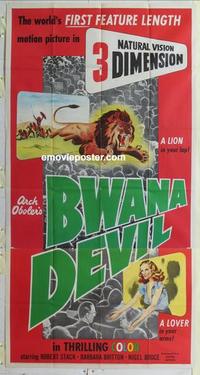

The duo brought their pictures in on time and under budget.
BWANA DEVIL 3D MOVIE MOVIE
DeMille first teamed with former ‘B’ movie publicity director Thomas in 1940. Pine, a former head of publicity at Paramount and associate producer under Cecil B. With 73 features and an accumulated box office take of $100 million behind them, Paramount entrusted their 3D unit in the care of the highly productive production duo, William H. “Then we got an old stereo-camera,” he continued, “with which we had been experimenting 15 years ago up from the basement and shot the picture in 3D with Technicolor.” Alas, all of the dye-transfer Technicolor, stereoscopy and advance word combined couldn’t make a box office smash out of Sangaree. “I stated that three-dimensional pictures were the next big thing in the industry,” Zukor wrote in his autobiography, “The Public is Never Wrong.“ With 10 days of 2D filming already in the can, Zukor took to the Sangaree soundstage and proceeded to call “cut!” on director Edward Ludwig’s set. No sooner did fledgling 3D productions Bwana Devil and House of Wax begin breaking box office records that Paramount stepped up and became the first major studio to develop its own in-house stereoscopic process, trade name: Paravision. Skip ahead 16 years when television posed a concrete threat to ticket sales and the time had finally arrived to dust off the stereoscopic cameras. At the time business was booming and there was no need for gimmickry to lure audiences. The design won Eduoart a technical Oscar in 1937, but Paramount board chairman Adolph Zukor initially chose not to put the process to use. The camera used to shoot Sangaree (1953) was designed by Paramount’s in-house special effects wizard, and rajah of rear screen projection, Farciot Eduoart. The trades referred to Paravision as Paramount’s “newly developed process” when in truth it had been around for years.

We’re talking depth, not width.īoth the Paravision and Panavision process had been around in 1953, but it wasn’t until 1972 that the latter had supplanted CinemaScope as the industry standard in widescreen cinematography. Stars Fernando Lamas, Arlene Dahl, Brian Keith, Lon Chaney, Jr., Richard Denning, Rita Moreno, Nestor Paiva.ĭid the heading of this trio of 3D Blu-ray releases from Kino Lorber provoke a double-take? Don’t worry. Stars Gene Barry, Rhonda Fleming, Agnes Moorehead, Teresa Brewer, Guy Mitchell. Stars Fernando Lamas, Arlene Dahl, Patricia Medina, Francis L. Paravision Dreams: The Golden Age 3D Films of Pine and Thomas


 0 kommentar(er)
0 kommentar(er)
